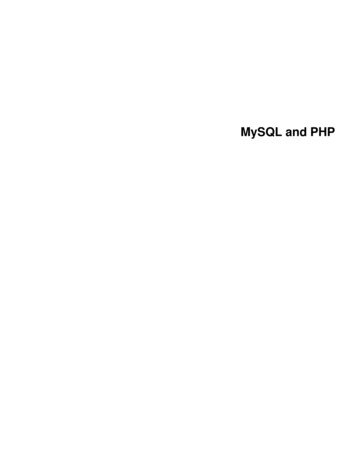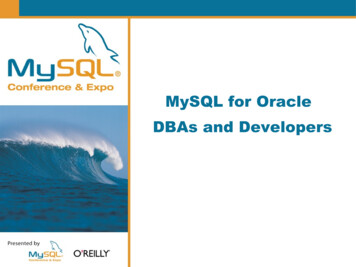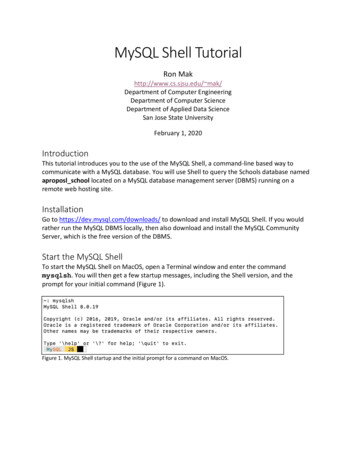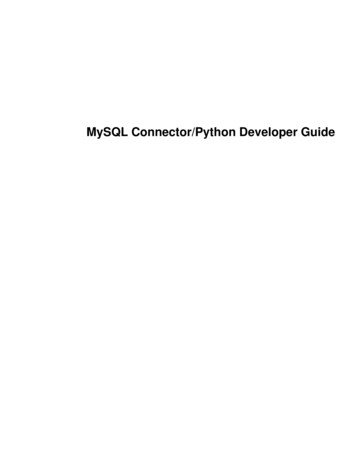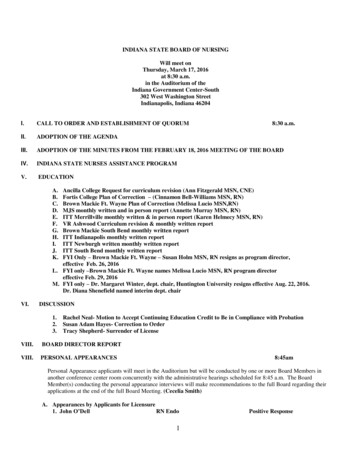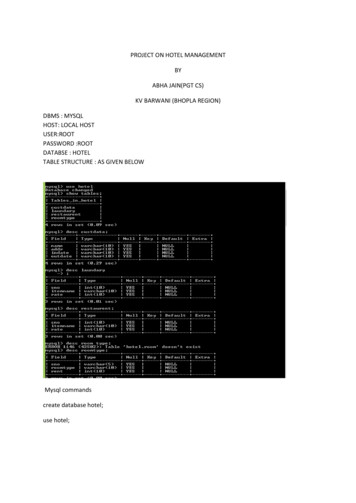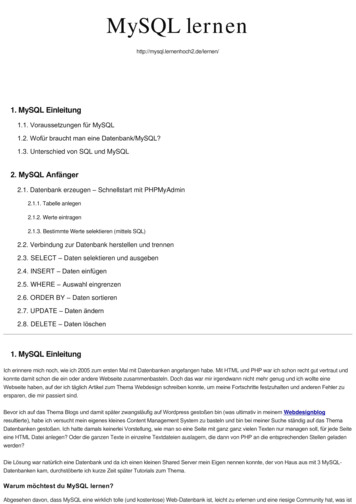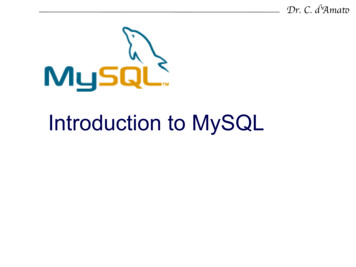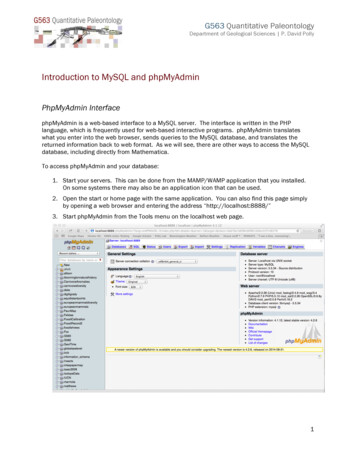
Transcription
G563 Quantitative PaleontologyDepartment of Geological Sciences P. David PollyIntroduction to MySQL and phpMyAdminPhpMyAdmin InterfacephpMyAdmin is a web-based interface to a MySQL server. The interface is written in the PHPlanguage, which is frequently used for web-based interactive programs. phpMyAdmin translateswhat you enter into the web browser, sends queries to the MySQL database, and translates thereturned information back to web format. As we will see, there are other ways to access the MySQLdatabase, including directly from Mathematica.To access phpMyAdmin and your database:1. Start your servers. This can be done from the MAMP/WAMP application that you installed.On some systems there may also be an application icon that can be used.2. Open the start or home page with the same application. You can also find this page simplyby opening a web browser and entering the address “http://localhost:8888/”3. Start phpMyAdmin from the Tools menu on the localhost web page.1
Import DataCreate Database: You can create new databases and import tables using phpMyAdmin. Create adatabase by clicking on the “New” link at the top of the left panel, or navigate to the Databases tab.Enter a name for your new database (e.g., “G563”) and select a “collation”, which is the encodingformat used to store text characters. The collation can be important for storing characters likevowels with umlauts or accents. When in doubt, chose “utf8 unicode ci”, which will handle mostcharacters from European alphabets.Create or Import Table: You can create tables that you fill with new data, or you can importexisting tables of data. Here is one way to import existing data from a file:1.Clean the data, including the column labels, and save in CSV format (comma-delimitedtext file). Labels should be at the top of each column. Things will go easier if the labelsare short, have no spaces, and have no unusual characters (e.g., -, , %, &, Ä, etc.).Labels should start with a letter, not a number. You can save CSV from Excel, or you cancreate a CSV file in a text editor or word processor.2.In phpMyAdmin, select the database into which you want to import the table.3.Using the import tab in phpMyAdmin, enter the name of the file using the file dialogbutton.4.Under “format” chose CSV, make sure column separators is set to comma (presumingyou are importing a comma delimited file.), and make sure to tick the option that readscolumn headers.5.Note the “replace table data with file” option. If you tick this, the data from theimported will overwrite all existing data in the MySQL table; if you don’t tick it, the datawill be added to whatever is in the table already. If you are importing into an empty file,this option has no effect.6.Press Go when you are ready.7.Change the name of the table to something useful. First, select it inphpM yAdm in, choose the Operations tab, and enter a new nam e under theTable Options section at the right.Debugging Im port problems: Check your data carefully for unannounced errors. Errorsfrequently arise because phpMyAdmin has guessed incorrectly the type of data in each column.1.Click on the structure tab to see what “type” has been assigned to your columns.Columns with text should be “varchar” (Variable characters), columns with integersshould be “int”, columns with ordinary decimal numbers should be “decimal” or “float”.2.Check to make sure that your data columns have not been truncated. This can happen ifthe first several rows are different from later rows. For example, if your first rows happento have integer numbers but later rows have decimals, the latter may have been lost.3.If there are problems you can try two things:a. Sort your data table in Excel so the largest numbers are first. Drop the old table.Import again.b. Create the table structure first, then import the data. Drop old table. Select thedatabase. Under Operations tab enter a name for the table and number of columnsin the appropriate fields and click Go. On next page enter the names of the columns,2
the data type, and the maximum length of each column. See here for quick guide todata types: https://my.bluehost.com/cgi/help/2161Introduction to SQL QueriesA database has tables, columns (also called fields) and rows. Tables and columns have names, rowshave data. The value of a database is that it allows you to find data, group data, link data, andsummarize data. For small data sets summaries may be easier made by hand, but with large datasets that are constantly changing this is easier done with queries. SQL (Structured Query Language)is a simple language that is used to query database, and it can be used in mySQL, Oracle, Access,and many others.The syntax of SQL queries is designed to be similar to a command in English. Most queries have atleast two parts: a verb clause, where the verb is usually “select”, and a prepositional clause thattells from which table (or tables) data should be selected. The modifying clause puts conditions onthe selection or the results. Several modifying clauses can be used, or none at all. The query abovewould select all columns (or fields) from the table “pbdb” for those rows where the Genus columncontains the word “Hesperocyon” (an extinct dog-like genus).The Select ClauseAn asterisk (*) is used to select all columns in a table. If you only want to see specific columns, listthem by name:If you just want a list of the taxa in your table, you can use the DISTINCT modifier to return only a listof the unique items in a field:You can combine words from different fields using the CONCAT() function, which is useful here forcombining genus and species names:In cases like this it is helpful to rename the fields, which you can do with the AS clause:There are other functions that operate on the data you retrieve:3
Max(field name)Min(field name)Count(field name)Avg(field name)Std(field name)Variance(field name)returns the maximum value of a field.returns minimum valuereturns the number of rowsreturns the meanreturns the population standard deviationreturns the population varianceThe Where ClauseUse the WHERE clause to select parts of data:You can combine items in the WHERE clause using all the logic statements that you thought wouldbe useless back when you learned them:Order By ClauseWant results in alphabetical order? Add an ORDER BY clause.The Group By Clause and Useful FunctionsHere’s where the usefulness of a database really becomes apparent. If you’re clever and your dataare arranged right you can calculate an entire table for a publication with one query:The previous query groups the data by genus and counts the rows for each genus, which gives youthe sample size for that genus, and renames the count as “N”.The following query gives you a summary of the stratigraphic ranges of all the genera in yourdatabase, ordered from the first appearance in the fossil record.The resulting table is very similar to the “ranges” table produced by the PBDB. If you downloadedthe right data in the collection database you can recreate the ranges table exactly using just oneSQL query. (oh, and you can put queries on more than one line if they are getting long).4
See the following page for a complete list of roup-by-functions.htmlExporting your resultsIf you want to save the results you generated in the Query Browser, you can copy and paste theminto Excel, or you can use the File menu to export the results as a comma-delimited file, which youcan then import into Excel (the latter works better for large data sets).5
Introduction to MySQL and phpMyAdmin PhpMyAdmin Interface phpMyAdmin is a web-based interface to a MySQL server. The interface is written in the PHP language, which is frequently used for web-based interactive programs. phpMyAdmin translates what you enter into the web browser, sends queries t
